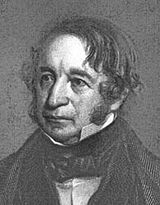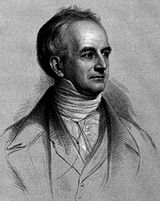
The Boston Associates
Encyclopedia



Nathan Appleton
Nathan Appleton was an American merchant and politician.- Biography :Appleton was born in New Ipswich, New Hampshire, the son of Isaac Appleton and his wife Mary Adams. Appleton's father was a church deacon, and Nathan was brought up in "strictest form of Calvinistic Congregationalism." He was...
, Patrick Tracy Jackson
Patrick Tracy Jackson
Patrick Tracy Jackson was a United States manufacturer, one of the founders of the Boston Manufacturing Company of Waltham, Massachusetts, and later a founder of the Merrimack Manufacturing Company whose developments formed the nucleus of Lowell, Massachusetts.-Biography:He was born in...
, Abbott Lawrence
Abbott Lawrence
Abbott Lawrence was a prominent American businessman, politician, and philanthropist...
, and Amos Lawrence
Amos Lawrence
Amos Lawrence, was an American merchant and philanthropist.-Biography:...
, often related directly or through marriage, they were based in Boston
Boston
Boston is the capital of and largest city in Massachusetts, and is one of the oldest cities in the United States. The largest city in New England, Boston is regarded as the unofficial "Capital of New England" for its economic and cultural impact on the entire New England region. The city proper had...
, Massachusetts
Massachusetts
The Commonwealth of Massachusetts is a state in the New England region of the northeastern United States of America. It is bordered by Rhode Island and Connecticut to the south, New York to the west, and Vermont and New Hampshire to the north; at its east lies the Atlantic Ocean. As of the 2010...
. By 1845, there were 31 textile companies—located in Massachusetts, New Hampshire
New Hampshire
New Hampshire is a state in the New England region of the northeastern United States of America. The state was named after the southern English county of Hampshire. It is bordered by Massachusetts to the south, Vermont to the west, Maine and the Atlantic Ocean to the east, and the Canadian...
, and southern Maine
Maine
Maine is a state in the New England region of the northeastern United States, bordered by the Atlantic Ocean to the east and south, New Hampshire to the west, and the Canadian provinces of Quebec to the northwest and New Brunswick to the northeast. Maine is both the northernmost and easternmost...
—produced one-fifth of all textile
Textile
A textile or cloth is a flexible woven material consisting of a network of natural or artificial fibres often referred to as thread or yarn. Yarn is produced by spinning raw fibres of wool, flax, cotton, or other material to produce long strands...
s in the United States. The textiles were a product of cotton, brought north from the southern cotton states by sea. With the capital earned through these mills, they invested in railroads
Rail transport
Rail transport is a means of conveyance of passengers and goods by way of wheeled vehicles running on rail tracks. In contrast to road transport, where vehicles merely run on a prepared surface, rail vehicles are also directionally guided by the tracks they run on...
, such as the Boston and Lowell
Boston and Lowell Railroad
The Boston and Lowell Railroad is a historic railroad that operated in Massachusetts. It was one of the first railroads in North America and the first major one in the state...
. These railroads helped transport the cotton from warehouses to factories. These Boston-based investors established banks—such as the Suffolk Bank
Suffolk Bank
Suffolk Bank was a clearinghouse bank in Boston, Massachusetts, that exchanged specie or locally backed bank notes for notes from country banks to which city-dwellers could not easily travel to redeem notes. It operated from 1818 until 1858....
—and invested in others. In time, they controlled 40% of banking capital in Boston, 40% of all insurance capital in Massachusetts, and 30% of Massachusetts' railroads. Tens of thousands of New Englanders received employment from these investors, working in any one of the hundreds of their mills.
Mill locations established or improved by the Boston Associates:
- Waltham, MassachusettsWaltham, MassachusettsWaltham is a city in Middlesex County, Massachusetts, United States, was an early center for the labor movement, and major contributor to the American Industrial Revolution. The original home of the Boston Manufacturing Company, the city was a prototype for 19th century industrial city planning,...
(1813) - Lowell, MassachusettsLowell, MassachusettsLowell is a city in Middlesex County, Massachusetts, USA. According to the 2010 census, the city's population was 106,519. It is the fourth largest city in the state. Lowell and Cambridge are the county seats of Middlesex County...
(1822) - Manchester, New HampshireManchester, New HampshireManchester is the largest city in the U.S. state of New Hampshire, the tenth largest city in New England, and the largest city in northern New England, an area comprising the states of Maine, New Hampshire, and Vermont. It is in Hillsborough County along the banks of the Merrimack River, which...
(1825) - Saco, MaineSaco, MaineSaco is a city in York County, Maine, United States. The population was 18,482 at the 2010 census. It is home to Ferry Beach State Park, Funtown Splashtown USA, Thornton Academy, as well as General Dynamics Armament Systems , a subsidiary of the defense contractor General Dynamics...
(1831) - Nashua, New HampshireNashua, New Hampshire-Climate:-Demographics:As of the census of 2010, there were 86,494 people, 35,044 households, and 21,876 families residing in the city. The population density was 2,719.9 people per square mile . There were 37,168 housing units at an average density of 1,202.8 per square mile...
(1836) - Dover, New HampshireDover, New HampshireDover is a city in Strafford County, New Hampshire, in the United States of America. The population was 29,987 at the 2010 census, the largest in the New Hampshire Seacoast region...
(1836) - Chicopee, MassachusettsChicopee, MassachusettsChicopee is a city located on the Connecticut River in Hampden County, Massachusetts, United States of America. It is part of the Springfield, Massachusetts Metropolitan Statistical Area. As of the 2010 census, the city had a total population of 55,298, making it the second largest city in...
(1838) - Lawrence, MassachusettsLawrence, MassachusettsLawrence is a city in Essex County, Massachusetts, United States on the Merrimack River. According to the 2010 U.S. Census, the city had a total population of 76,377. Surrounding communities include Methuen to the north, Andover to the southwest, and North Andover to the southeast. It and Salem are...
(1845) - Holyoke, MassachusettsHolyoke, MassachusettsHolyoke is a city in Hampden County, Massachusetts, United States, between the western bank of the Connecticut River and the Mount Tom Range of mountains. As of the 2010 Census, the city had a population of 39,880...
(1847)
See also
- Boston Manufacturing CompanyBoston Manufacturing CompanyThe Boston Manufacturing Company was organized in 1813 by Francis Cabot Lowell, a wealthy Boston merchant, in partnership a group of investors known as The Boston Associates, for the manufacture of cotton textiles. Boston Manufacturing Company gathered many of their trade secrets from the earlier...
- Francis Cabot Lowell (businessman)
- Paul Moody (inventor)
Further reading
- Robert SobelRobert SobelRobert Sobel was an American professor of history at Hofstra University, and a well-known and prolific writer of business histories.- Biography :...
The Entrepreneurs: Explorations Within the American Business Tradition (Weybright & Talley 1974), chapter 1, Francis Cabot Lowell: The Patrician as Factory Master. ISBN 0-679-40064-8 - Carl E. Prince, Seth Taylor. Daniel Webster, the Boston Associates, and the U.S. Government's Role in the Industrializing Process, 1815-1830. Journal of the Early Republic, Vol. 2, No. 3 (Autumn, 1982), pp. 283-299
- Robert F. Dalzell, Jr. Enterprising Elite, The Boston Associates and the World They Made. Cambridge, MA: Harvard University Press, 1987.
- Francois Weil; "Capitalism and Industrialization in New England, 1815-1845." The Journal of American History, Vol. 84, No. 4 (Mar., 1998), pp. 1334-1354.
- Anne Farrow; John Lang; Jennifer Frank; "Complicity: How the North Promoted, Prolonged, and Profited from Slavery." Chapter 1. Ballantine Books, The Hartford Courant Company: Hartford, Connecticut. 2005.

